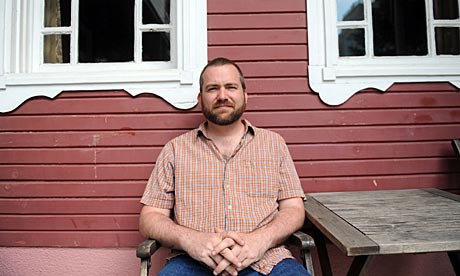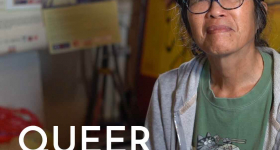On June 16, 2011, Jon Stewart appeared on his popular news program “The Daily Show” to report on one of the most shocking journalistic hoaxes to occur in recent memory. The popular and widely read “Gay Girl in Damascus” blog by “Amina Abdallah Arraf,” a young lesbian Syrian woman, was discovered to have been written in a dorm room by Tom McMaster, a white 40 year old American graduate student living in Scotland.

CNN had earlier described “Amina” as an “icon of the Syrian uprising,” and no wonder: the media lockdown in Syria had made it difficult for Western journalists to cover this story and they had quoted her extensively as an authority on the “Arab Spring.” As Ethan Zuckerman, the founder of an organization devoted to reporting the news from the perspective of citizens living in oppressive regimes, wrote in his blog, “it’s worth remembering that the country has closed its borders to foreign journalists. As I observed in analyzing media coverage of the 2009 Iran green movement protests, when countries close themselves to international media, there’s a tendency to report stories relying heavily on social media.” Thus, CNN, the Guardian, the Huffington Post, the Washington Post, and many other news publishers cited “Amina’s” blog in great detail as an authority on the events in Syria, only to become deeply embarrassed as the hoax was revealed.
However, this hoax had another, even weirder, twist. As if the impersonation of a lesbian Syrian blogger by a white man were not enough, “Paula Brooks,” a white lesbian deaf mother of twins and an editor of the blog “Lez Get Real: A Gay Girl’s View of the World” which published Amina’s column, was revealed to be Bill Graber, a 51 year old white man. John Stewart, clearly overwhelmed by this revelation, shouted, “I’m completely f-ing freaked out. Because it turns out that the lesbians we care the most about in the world are dudes!”
McMaster and Graber are not the first to have created fictional identities on the Internet. Indeed, long before we had a graphical web, streaming video, or even a commercial Internet, users were populating social spaces like chatrooms and virtual worlds with personae that were differently gendered, raced, and embodied. In 1995 I published an essay entitled “Race In/For the Cyberspace: Identity Tourism and Racial Passing on the Internet” that described how white men in early chatrooms impersonated Asian women to get attention in these new social spaces. I coined the term “identity tourism” to describe this new type of behavior. For it was obvious to me that these white men were choosing Asian female personae for a reason -- the currency of the sexy, submissive Asian girl proved to be attractive and powerful in the new attention economy of online interaction in a way that, say, African American women and white men were not.
That was 16 years ago, and the Internet looks much different than it did then, yet identity tourism is still alive and well. It’s tempting to read MacMaster’s and Graber’s behavior as “sick” or pathological, yet it makes perfect sense in light of what they were trying to accomplish. Getting strangers to talk to you and give you attention is much easier when you’re an attractive lesbian Asian girl with an important story to tell than if you’re a frumpy white middle-aged graduate student, as was MacMaster.
The Amina case has proven to be a real embarrassment to the journalists who reported on Syria using her blog and on-line interviews as sources, without having ever seen her in person or on Skype. Social media has supposedly taken a pie in the face as a potentially bogus and unreliable way to learn about what’s really going on in other countries. However, I’m less interested in how these straight white men got away with their identity tourism as lesbian women online and what this means for journalism -- more interested in MacMaster and Graber’s own justifications, explanations, and excuses.
In an interview with the Guardian after Amina was outed as Tom, Tom MacMaster explains that blogging as Amina was a huge “time-suck” and that he resolved to quit several times when it became clear that Amina had “gone viral.” He knew that it was only a matter of time until he got caught. So why did he do it? Why couldn’t he stop?
The answer lies in Stewart’s canny punchline: “the lesbians we care the most about in the world are dudes!” The Internet has been described as a digital commons, an open marketplace of ideas, a space where all are listened to equally. Yet even when the Internet was a much smaller place, in 1995, white men were availing themselves of its anonymity to create exotic female identities for the same reason then as now--to get other users to write to them, give them support and encouragement, and create sexual relationships. (MacMaster had a 500 email correspondence with Sandra Bagaria, a Western lesbian he duped into an online relationship with him).
MacMaster and Graber learned first-hand that appropriating lesbian identities would give them readers and afford them entry to a close-knit community that they could never hope to penetrate in real life. Even better, they could become a part of this community without having to endure the humiliations and inconvenience that real lesbians must face. Amina’s bravery as an “out” lesbian in a repressive political regime drew readers and journalists who were eager for inspiring stories of queer women of color. And MacMaster’s cowardice and need for respect and attention made it impossible for him to stop creating these stories.
In MacMaster’s skype interview with the Guardian UK he is asked, point-blank, why he created Amina, and he replies that he had long tried to post his thoughts on pro-Arab politics but had found his identity as a white American man to be a problem. Creating a female Arab identity solved that problem, because “first, there would be some deference from obnoxious men, just because people would be more polite to a girl than to a guy, and second, people won’t get hung up on why do you hate.” MacMaster explained that he had extensive knowledge of the Syrian political situation, garnered partly from his wife, a Middle East expert who was also a graduate student, but that he knew that his ideas would receive less attention and respect if he blogged them as his own.
Ultimately, he blames the news media and US cultural politics for driving him to this masquerade. In this interview he explains that he wrote the blog to critique “liberal Orientalism,” the commonly held view that Islamic societies are homophobic and deserve to be quelled for this reason. MacMaster is a graduate student, and in his video interview he switches eerily into the voice of a scholar of Asian American studies as he gives the interviewer a short history lesson in postcolonial theory. He claims that just as 19th century colonial British men justified their subjugation of India by targeting its “effeminate” and pro-gay culture, so too today liberal Arab-haters target Islam’s homophobia as reason to suppress it. By creating a gay, devoutly Muslim female Syrian woman who blogged in support of her country’s right to democracy and strongly critiqued Israel’s policies, he hoped to silence these “liberal” critics of Islam.
In her brilliant book Can The Subaltern Speak? , postcolonial theorist Gayatri Spivak writes that colonists justified their subjugation of the Orient by citing practices such as “suttee,” or wife-burning, as evidence that “Orientals” were too perverse, savage, and cruel to women to govern themselves. Though these colonists made no actual efforts to talk to or learn from Indian women themselves, they appropriated and indeed fictionalized their positions in order to justify their oppression. In effect, they spoke for them. We can only really know our own positions as subjects, and to speak from the point of view of someone else -- a lesbian, a women, an “Oriental” -- to engage in the worst kind of bad faith. In an oft-quoted phrase Spivak characterizes this as “white men...saving brown women from brown men.”
Tom MacMaster was tempted by and ultimately gave in to his desire to speak literally as the subaltern -- as the queer female Asian-Islamic subject -- for many reasons, but perhaps the most obvious one is his conviction that he was the victim of reverse racism. Enjoying the privileges and security of being a white American man was not enough for him, indeed, as he explains in his blog, his privileged identity proved to be a problem when he wanted others to pay attention to and agree with his opinions about Syria. “I noticed that when I, a person with a distinctly Anglo name, made comments on the Middle East, the facts I might present were ignored and I found myself accused of hating America, Jews, etc. I wondered idly whether the same ideas presented by someone with a distinctly Arab and female identity would have the same reaction.” MacMaster argued that he was the victim of reverse discrimination as a white man, for quite reasonably, news outlets wanted news from Syrians, particularly news from those who are the most marginalized in that culture -- women and gay people.
Thus, MacMaster met this demand by creating exactly this kind of news by writing as someone else -- the queer subaltern. Instead of white men saving brown women from brown men as earlier colonists had done in India, MacMaster was saving a white man--himself -- from other white men who denied him the attention he demanded. He did this by becoming a queer brown woman.
Real lesbians in Damascus may have a harder time being taken seriously or believed as a result of MacMaster’s identity tourism, and for that MacMaster has apologized, albeit lamely. However, the underlying dynamic is the same as it was 15 years ago during the Internet’s early days, or a hundred years ago, or even longer than that. Privilege is addictive, and it needs alibis to justify its own existence in a changing world. White men who colonized the Orient blamed and continue to blame the victims -- Indians, West Asians, Afghans, Iranians -- for their primitive ways and concomitant need to be governed. At the same time, during decolonization “brown men” asserted their rights to self-determination and native customs, some of which did indeed oppress women, and defended them by attributing them to women’s own desires. Nobody asked the women themselves where their desires lay.
So what does the fake Amina media hoax mean?
It’s been said that the problem with the Internet is that it repeats or amplifies a limited number of opinions and ideas rather than encouraging diverse viewpoints and productive exchange. It tells us what we want to hear. Telegenic images of light-skinned beautiful women such as Neda Soltani, killed during a demonstration in Iran and filmed by a bystander’s cellphone, are marketed much more strongly by the media than are other, more prosaic images of Arab women. The image that MacMaster circulated as Amina’s belonged to a Croatian woman living in London. As MacMaster said, as soon as her saw her beautiful and somewhat sad face he knew that she was his Amina.
The Amina incident is a classic example of this echo chamber effect; rather than listening to subaltern women tell their story, the largely white news media eagerly listened to a white man spin out a tale of Oriental intrigue, kidnapping, lesbian sex, and pro-Muslim, pro-democracy rhetoric and believed him. Like the Persian Scheherazade, the storyteller from A Thousand and One Nights who told the Sultan a new story every night to stay her execution, MacMaster blogged a new and exciting tale of queer Orientalism that entranced journalists and readers alike.
It’s not the Internet’s anonymity that’s to blame. As Spivak wrote, women of color need to plot their own histories online and off and we need to listen to them, and not only during the “Arab Spring.” Though Edward Said, the scholar who coined the term “Orientalism,” died recently and is therefore unable to comment on the story, his daughter Najla was interviewed about MacMaster. She summed up Orientalism as follows: "Orientalism is: I don't need you telling my story."
* * *
Lisa Nakamura is the director of the Asian American Studies Program, professor in the Institute of Communication Research and Media Studies and Cinema Studies Department and professor of Asian American Studies at the University of Illinois, Urbana Champaign. She is the author of Digitizing Race: Visual Cultures of the Internet (2008), Cybertypes: Race, Ethnicity and Identity on the Internet (2002) and co-editor of Race in Cyberspace (2000) and Race After the Internet (forthcoming 2011).
She would like to thank Christina Xu of the Awesome Foundation for bringing her attention to the link between identity tourism and the Gay Girl in Damascus hoax.
You've just read a post from Across the Desk: a collaboration of Asian American journalists and scholars. See here
for more in the series. Scholars and journalists interested in
contributing, please email the series editor at
erin[at]hyphenmagazine[dot]com.









Comments
We have corrected our error.
thank you, Huma!
corrected. our readers have eagle eyes. which is why we respect them so.